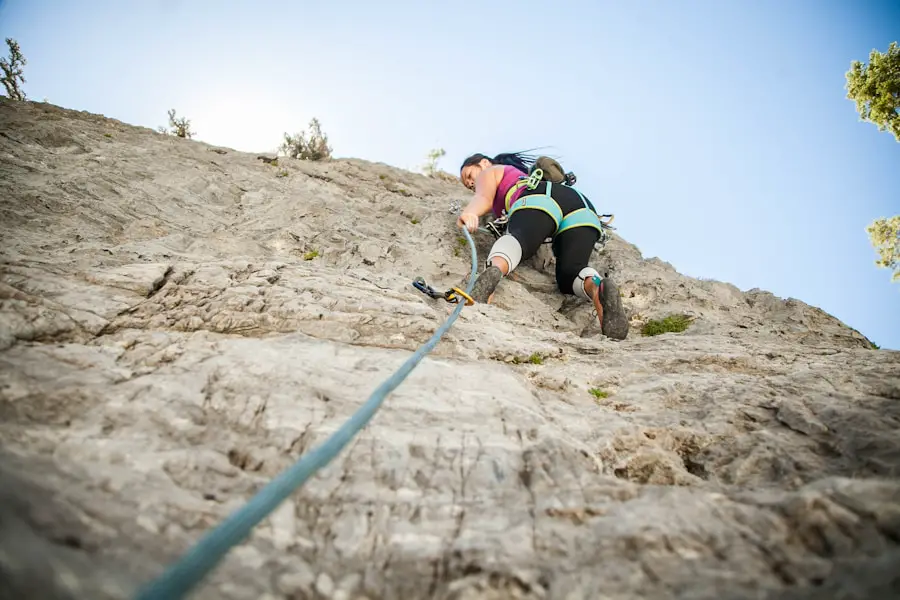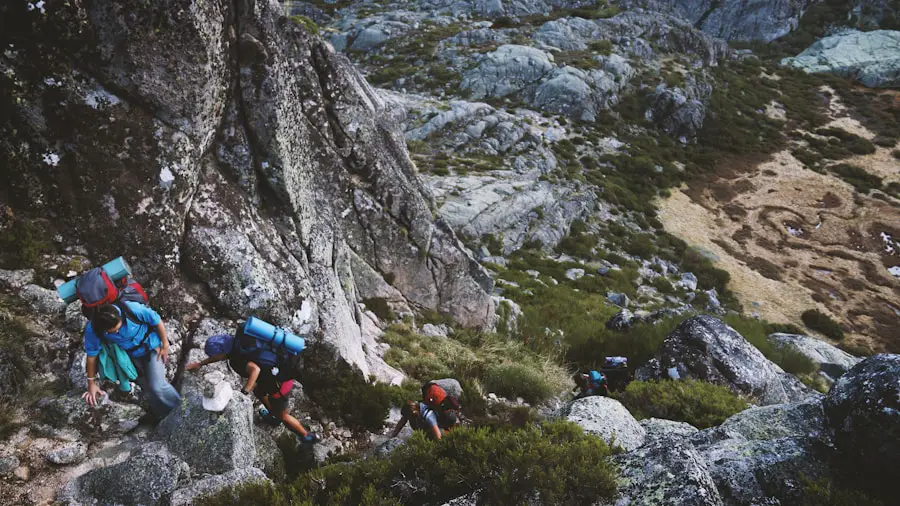Scrambling hiking is an exhilarating outdoor activity that combines elements of hiking and climbing, allowing adventurers to traverse rugged terrains that are often inaccessible by traditional trails. Unlike standard hiking, which typically follows well-defined paths, scrambling involves navigating over rocks, boulders, and steep inclines, requiring both physical agility and mental acuity. This activity can range from simple rock hopping to more technical ascents that may require the use of hands for balance and support.
The appeal of scrambling lies in its ability to immerse participants in nature while providing a sense of challenge and accomplishment. The origins of scrambling can be traced back to the early mountaineering pursuits in the 19th century, where climbers sought to explore the less-traveled paths of mountainous regions. Today, scrambling is recognized as a distinct category of outdoor recreation, often categorized into grades that indicate the level of difficulty.
These grades help enthusiasts gauge their skills and choose appropriate routes. For instance, Grade 1 scrambles are generally straightforward and suitable for beginners, while Grade 3 scrambles may involve more technical climbing and require a higher level of experience and equipment. Understanding these classifications is crucial for anyone looking to engage in scrambling hiking.
Key Takeaways
- Scrambling hiking involves navigating steep and rocky terrain, often requiring the use of hands for balance and support.
- Essential gear for scrambling hiking includes sturdy hiking boots, a helmet, gloves, and a backpack with extra layers and supplies.
- Safety tips for scrambling hiking include staying focused, using proper handholds and footholds, and being aware of weather conditions and potential hazards.
- When choosing a scrambling hiking route, consider the difficulty level, terrain, and your own experience and comfort level.
- Scrambling hiking offers physical benefits such as improved strength and balance, as well as mental benefits like stress relief and a sense of accomplishment.
Essential Gear for Scrambling Hiking
When preparing for a scrambling hiking adventure, having the right gear is paramount to ensure safety and enhance the overall experience. The foundation of any outdoor excursion begins with appropriate footwear. Sturdy hiking boots with good ankle support and a robust tread pattern are essential for navigating uneven surfaces and providing traction on rocky terrain.
Many scramblers opt for approach shoes, which offer a balance between hiking comfort and climbing performance, allowing for better grip on both rock and trail. In addition to footwear, a well-fitted backpack is crucial for carrying essential items such as water, snacks, first aid supplies, and navigation tools. Hydration systems or water bottles should be easily accessible, as staying hydrated is vital during strenuous activities.
A map and compass or a GPS device can help keep adventurers oriented in unfamiliar areas. Furthermore, protective gear such as a helmet is advisable when tackling more challenging scrambles, as it can safeguard against falling rocks or slips. Other useful items include gloves for better grip on rocky surfaces, trekking poles for stability, and weather-appropriate clothing to adapt to changing conditions.
Safety Tips for Scrambling Hiking

Safety should always be a top priority when engaging in scrambling hiking. One of the most critical aspects is understanding one’s own skill level and recognizing when a route may be too challenging. It is essential to assess personal capabilities honestly and choose routes that match one’s experience.
Additionally, it is wise to research the specific scramble beforehand, as conditions can vary significantly based on weather, time of year, and local geology. Another vital safety consideration is the buddy system. Scrambling with a partner not only enhances safety but also provides an opportunity for shared experiences and mutual support during challenging sections.
In case of an emergency, having someone nearby can make a significant difference. Moreover, it is crucial to communicate effectively with your partner about your pace and comfort levels throughout the hike. Carrying a first aid kit and knowing basic first aid techniques can also be invaluable in case of injuries or accidents.
Choosing the Right Scrambling Hiking Route
| Route Name | Difficulty Level | Distance (miles) | Elevation Gain (feet) |
|---|---|---|---|
| Angel’s Landing, Zion National Park | Difficult | 5.4 | 1488 |
| Half Dome, Yosemite National Park | Very Difficult | 14.2 | 4800 |
| Longs Peak, Rocky Mountain National Park | Extremely Difficult | 14.5 | 5100 |
Selecting an appropriate scrambling route is fundamental to ensuring an enjoyable experience. Factors such as personal skill level, physical fitness, and environmental conditions should all be taken into account when making this decision. Beginners may want to start with well-marked routes that have clear descriptions available in guidebooks or online resources.
These routes often feature less technical sections and provide opportunities to build confidence before tackling more challenging scrambles. In addition to personal capabilities, it is essential to consider the weather forecast and seasonal conditions. Some scrambles may become significantly more difficult or dangerous during wet or icy conditions.
Researching local climbing forums or websites can provide insights into current trail conditions and any potential hazards. Furthermore, understanding the terrain type—whether it be granite, sandstone, or limestone—can influence route selection as different rock types present varying levels of difficulty and risk.
The Physical and Mental Benefits of Scrambling Hiking
Engaging in scrambling hiking offers numerous physical benefits that contribute to overall health and fitness. The activity demands a combination of strength, endurance, balance, and flexibility as participants navigate uneven surfaces and ascend steep inclines. This multifaceted physical engagement helps build muscle tone in the legs, core, and upper body while also improving cardiovascular fitness through sustained exertion.
Regular participation in scrambling can lead to enhanced coordination and proprioception, which are essential skills for navigating complex terrains. Beyond the physical advantages, scrambling hiking also provides significant mental health benefits. The focus required during a scramble encourages mindfulness, allowing participants to immerse themselves fully in the present moment while navigating challenges.
This mental engagement can serve as a form of stress relief, providing an escape from daily pressures and fostering a sense of accomplishment upon completing a challenging route. Additionally, spending time in nature has been shown to improve mood and reduce symptoms of anxiety and depression, making scrambling not only a physically rewarding activity but also a powerful tool for mental well-being.
Exploring Scrambling Hiking in Different Terrains

Scrambling hiking can be experienced across various terrains, each offering unique challenges and rewards. In mountainous regions, such as the Rockies or the Alps, scramblers may encounter rugged granite faces that require careful foot placement and handholds for ascent. These areas often provide breathtaking views at higher elevations but demand respect for altitude-related challenges such as thinner air and changing weather conditions.
Conversely, coastal scrambles along cliffs or rocky shorelines present their own set of challenges. The terrain may be less stable due to erosion or tidal influences, requiring scramblers to remain vigilant about their footing while navigating slippery rocks or loose gravel. Coastal scrambles often reward adventurers with stunning ocean vistas and opportunities to observe marine wildlife up close.
Each terrain type not only tests different skills but also enriches the overall experience by showcasing diverse landscapes that inspire awe and appreciation for nature’s beauty.
How to Prepare for a Scrambling Hiking Adventure
Preparation is key to ensuring a successful scrambling hiking adventure. Before setting out, it is essential to conduct thorough research on the chosen route. This includes studying maps, reading trail reviews from other hikers, and checking local regulations or permits required for access.
Understanding the specific challenges posed by the route—such as technical sections or exposure—can help adventurers mentally prepare for what lies ahead. Physical preparation is equally important; engaging in regular fitness activities that build strength and endurance will enhance performance during scrambles. Activities such as rock climbing, bouldering, or even yoga can improve balance and flexibility while also building confidence in handling challenging movements on rocky terrain.
Additionally, practicing navigation skills using maps or GPS devices can ensure that adventurers feel equipped to handle any unexpected detours or challenges during their hike.
Finding Scrambling Hiking Communities and Resources
Connecting with fellow scrambling enthusiasts can greatly enhance one’s experience in this adventurous pursuit. Many regions have local clubs or organizations dedicated to hiking and climbing that offer group outings, workshops, and training sessions tailored specifically for scramblers of all skill levels. Joining these communities not only provides opportunities for learning from experienced individuals but also fosters camaraderie among like-minded adventurers who share a passion for exploring rugged landscapes.
Online resources are also invaluable for those seeking information about scrambling routes or safety tips. Websites dedicated to outdoor activities often feature forums where users can share experiences, post questions, and exchange advice on various scrambles around the world. Social media platforms have also become popular venues for connecting with other outdoor enthusiasts; many groups focus specifically on scrambling or climbing activities where members can share photos, tips, and upcoming events.
Engaging with these communities can provide inspiration for future adventures while also ensuring that individuals remain informed about best practices in scrambling hiking.
If you enjoy scrambling hiking, you may also be interested in discovering 5 amazing tent camping spots near you this spring 2025. These camping spots offer a unique opportunity to connect with nature and enjoy the great outdoors. Check out the article here for more information on these fantastic camping destinations.
Love travel? Join Our Facebook Community For More Tips.
FAQs
What is scrambling hiking?
Scrambling hiking is a type of outdoor activity that involves a combination of hiking and climbing. It typically takes place on steep, rocky terrain where the use of hands is necessary for balance and progress.
What skills are required for scrambling hiking?
Scrambling hiking requires a good level of physical fitness, as well as basic rock climbing skills such as route finding, balance, and the ability to use hands and feet to navigate rocky terrain.
What equipment is needed for scrambling hiking?
Essential equipment for scrambling hiking includes a helmet, sturdy hiking boots with good grip, a harness, a rope, and a climbing protection system such as cams or nuts. It is also advisable to carry a map, compass, and first aid kit.
What are the risks associated with scrambling hiking?
Scrambling hiking can be risky due to the steep and exposed nature of the terrain. Risks include falls, rockfall, and getting lost. It is important to assess the route, be prepared for changing weather conditions, and have the necessary skills and equipment to mitigate these risks.
Where can I go scrambling hiking?
Scrambling hiking can be done in mountainous and rocky areas around the world. Popular destinations for scrambling hiking include the Scottish Highlands, the Lake District in England, the Rocky Mountains in the United States, and the Dolomites in Italy.
